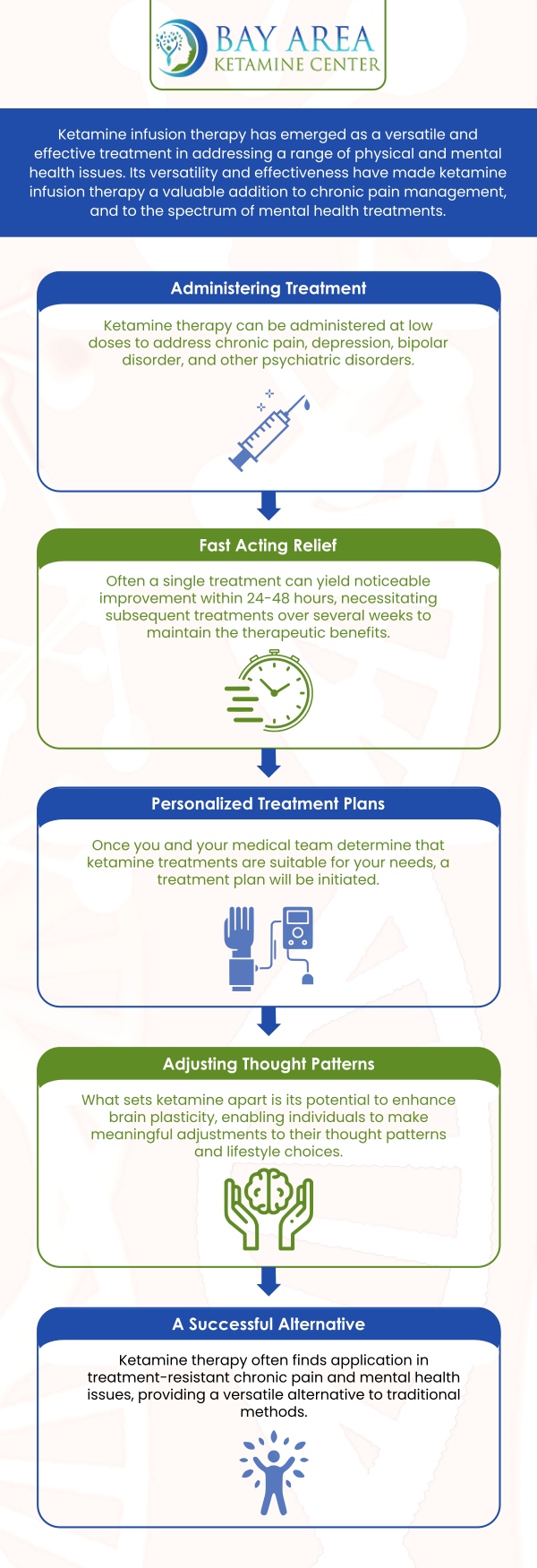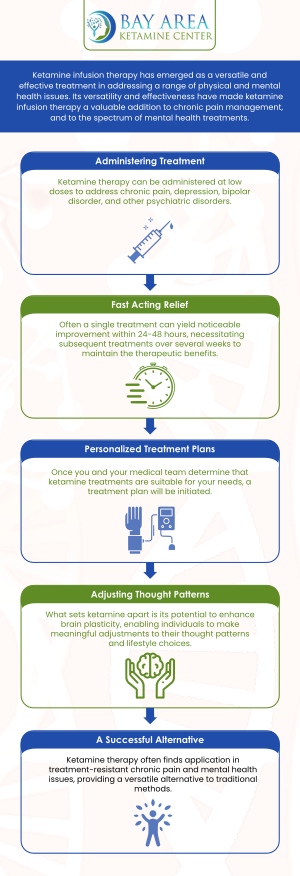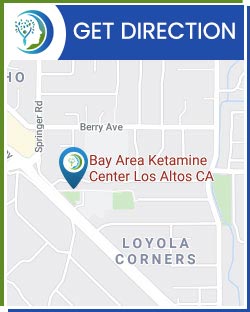Long-Term Effects of Ketamine Infusions Q&A
Ketamine infusions can provide lasting relief for conditions like depression, anxiety, and chronic pain. Long-term use should be monitored to manage potential side effects like memory changes or blood pressure fluctuations. At Bay Area Ketamine Center, our team will ensure you receive safe and effective care tailored to your needs. For more information contact us or book an appointment online. We are conveniently located at 746 Altos Oaks Drive Suite B, Los Altos, CA 94024.




Table of Contents:
What are the benefits of ketamine infusion therapy?
What to expect with ketamine infusion therapy?
What are the short and long-term side effects of ketamine infusions ?
How long can you be on ketamine infusion therapy?
Ketamine is able to block NMDA receptors in the brain, which play a significant role in pain perception, memory, and learning. By obstructing these receptors, ketamine is able to inhibit the transmission of pain signals from the brain to the body, acting as an effective pain reliever.
The drug also possesses anti-inflammatory and antidepressant properties, which are attributed to the release of neurotransmitters such as dopamine and serotonin that are stimulated by ketamine. These neurotransmitters are known to regulate mood and other vital physiological functions.
Ketamine infusion therapy is a safe and effective treatment option for various mental health issues. It has minimal side effects and is relatively affordable compared to other treatment options. In addition to its safety, ketamine has the ability to improve depression and anxiety symptoms within a few hours.
It can also help with other symptoms such as moodiness, hopelessness, decreased concentration, low self-esteem, impaired sleep, decreased sexual desire, and impaired appetite. Patients who have tried other treatments with no success may find ketamine infusion therapy to be a beneficial alternative. The fast-acting effects of ketamine make it an attractive option for those who need immediate relief from their symptoms.
The first treatment of ketamine infusion therapy begins with a moderate dose for the first ketamine infusion to ensure that the patient is introduced smoothly to the experience. Subsequent infusions are titrated to ensure the best possible treatment outcome and a well-tolerated experience.
Patients often report experiencing a dreamlike state of dissociation during the infusion, with various colors or shapes seen, and feeling as though they are floating or sinking into the chair.
During the infusion, there is typically a slight increase in breathing rate and a moderate increase in heart rate and blood pressure. Despite this, patients remain aware of their presence in the treatment suite and can communicate with the staff at the clinic, while also being tuned into an alternate reality.
Many find this experience to be relaxing and a temporary escape from the conditions that led them to seek treatment. However, some patients may not enjoy the mind-altering component of the treatment, but tolerate it given the dramatic improvement in their symptoms post-treatment.
After the infusion, the dissociative effects of the ketamine infusion quickly subside, and patients are able to walk out of the clinic, although they will need someone to drive them home. Typically, patients have something light to eat and may take a nap or rest for an hour. Following a good night’s rest, patients can return to their normal activities, including driving, attending school or work.
Ketamine infusions can produce some short-term and long-term side effects. Short-term side effects usually subside within a few hours after the infusion and may include feelings of disorientation, confusion, dizziness, or blurred vision.
Some patients may experience nausea or mild headaches. The sensation of floating or sinking, and vivid dreams or hallucinations may also occur. These side effects are usually mild and can be easily managed.
Long-term side effects are rare and are usually associated with repeated or chronic use of ketamine. They may include bladder dysfunction, increased blood pressure, and liver damage. However, these side effects are uncommon with the low doses used in ketamine infusion therapy, and the benefits of the treatment usually outweigh the risks.
Patients with a history of substance abuse or addiction may be at a higher risk of developing abuse or addiction to ketamine, although this is also rare in the context of ketamine infusion therapy. It is important for patients to inform their healthcare provider of any previous or current substance abuse issues before undergoing ketamine infusion therapy.
The length of time that a person can be on ketamine infusion therapy varies depending on the individual’s specific needs and response to treatment. Generally, ketamine infusion therapy is administered over a series of several sessions, typically ranging from four to six treatments.
The frequency and duration of these sessions may vary based on the individual’s response to treatment. After the initial series of treatments, some individuals may require ongoing maintenance sessions to sustain the benefits of the treatment. The frequency of these maintenance sessions will depend on the individual’s response and can range from weekly to monthly.
Ketamine infusion therapy is available at Bay Area Ketamine Center. For more information contact us or book an appointment online. We are conveniently located at 746 Altos Oaks Drive Suite B, Los Altos, CA 94024. We serve patients from Los Altos CA, Sunnyvale CA, Palo Alto CA, Stanford CA, Atherton CA, Cupertino CA, Santa Clara CA, Mountain View CA, Loyola CA, and surrounding areas.

Check Out Our 5 Star Reviews







